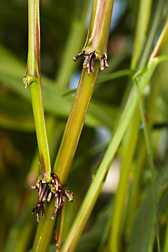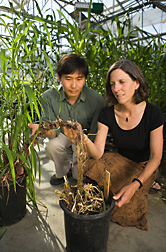Corngrass
Youthful Plant Harbors Prized Genes
Corngrass—a somewhat grassier-looking version of your typical towering cornstalk—may hold a key to fast, cheap, eco-friendly ways to squeeze more cellulosic ethanol from corn and other bioenergy crops.
This unusual plant is the same species—Zea mays—as the corn grown on millions of acres of American farmland. A healthy, naturally occurring mutant of those familiar plants, corngrass has several traits that might be suitable for moving into other plants to make them superior biofuel crops.
Scientists are interested, for example, in corngrass’s ability to create more biomass—plant material that can be converted into biofuels—than conventional corn plants. Corngrass does that by forming significantly more branches, or shoots, called “tillers.” They grow from the base of the stalk and make their own roots, known as “prop roots.”
What’s more, corngrass has less lignin in its tender, youthful leaves than conventional corn plants have in their tougher foliage. That’s a plus for corngrass, because lignin and other components of plant cell walls present stumbling blocks to producing cellulosic ethanol efficiently. These components don’t yield easily to the deconstruction tactics typically used today to convert plants into the fermentable sugars from which ethanol is produced.
“Corngrass retains its juvenile features longer—including the tenderness of its leaves,” says George S. Chuck, a plant molecular geneticist at the ARS/University of California-Berkeley Plant Gene Expression Center in Albany. In a study published in a 2007 issue of Nature Genetics, Chuck and colleagues found and copied, or cloned, what they refer to as “the Corngrass gene.” The gene carries the instructions that the plant uses to form what’s known as a “microRNA.” In turn, this microRNA likely controls at least seven genes, the scientists discovered. Those seven or so genes make corngrass different from conventional corn in terms of biomass, lignin levels, and other features needed to create stand-out biofuel crops. Chuck did the work with Plant Gene Expression Center director Sarah C. Hake; Koy Saetuern, formerly at the center; and A. Mark Cigan of Pioneer Hi-Bred International, Johnston, Iowa.
Now, Chuck and Hake are taking an even closer look at the microRNA and the genes it influences. They’re doing that with funding from ARS, UC-Berkeley, and a new grant from the U.S. Department of Energy.
Among their collaborators is Christian M. Tobias, a plant molecular biologist with ARS’s Western Regional Research Center, at Albany. Tobias plans to shuttle the corngrass microRNA into switchgrass and then determine whether that move boosts switchgrass’s value as a bioenergy source.—By Marcia Wood, Agricultural Research Service Information Staff.
This research is part of Plant Genetic Resources, Genomics, and Genetic Improvement (#301) and Plant Biological and Molecular Processes (#302), two ARS national programs described on the World Wide Web at www.nps.ars.usda.gov.
George S. Chuck and Sarah C. Hake are with the USDA-ARS/University of California-Berkeley Plant Gene Expression Center, 800 Buchanan St., Albany, CA 94710; phone (510) 559-5922 [Chuck], (510) 559-5907 [Hake], fax (510) 559-5678.
Christian M. Tobias is with the USDA-ARS Western Regional Research Center, Genomics and Gene Discovery Research Unit, 800 Buchanan St., Albany, CA 94710; phone (510) 559-6172, fax (510) 559-5818.
"Corngrass: Youthful Plant Harbors Prized Genes" was published in the November/December 2008 issue of Agricultural Research magazine.








